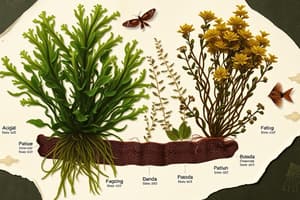Podcast
Questions and Answers
True or False: The group called algae is composed of members that have eukaryotic type of cells only (eukaryotic and prokaryotic).
True or False: The group called algae is composed of members that have eukaryotic type of cells only (eukaryotic and prokaryotic).
True (A)
True or False: Seaweeds are a group of macroalgae that exhibit root-like (stipe), stemlike (holdfast), and leaf-like (blade) parts in their thalli that have no vascular tissues.
True or False: Seaweeds are a group of macroalgae that exhibit root-like (stipe), stemlike (holdfast), and leaf-like (blade) parts in their thalli that have no vascular tissues.
True (A)
True or False: Filamentous algae are composed of cells that are in the form of a chain that are produced by cells that divide in only two directions.
True or False: Filamentous algae are composed of cells that are in the form of a chain that are produced by cells that divide in only two directions.
False (B)
True or False: The apparent color of algae is due to the wavelength of light absorbed (reflected) by its main photosynthetic pigment and dominant accessory pigments.
True or False: The apparent color of algae is due to the wavelength of light absorbed (reflected) by its main photosynthetic pigment and dominant accessory pigments.
True or False: Accessory pigments are produced by an alga in order to absorb the wavelengths of light that are not absorbed by the main photosynthetic pigment chlorophyll A and also to protect chlorophyll A from damage due to high light intensity.
True or False: Accessory pigments are produced by an alga in order to absorb the wavelengths of light that are not absorbed by the main photosynthetic pigment chlorophyll A and also to protect chlorophyll A from damage due to high light intensity.
Flashcards are hidden until you start studying




